Car Stories
Published in: 33. Transcription of Multitudes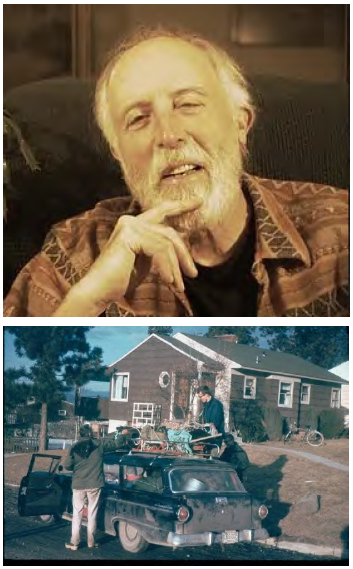
About the Author: Bill Yake (1947-2022) — American poet and environmentalist, author of three poetry collections: This Old Riddle: Cormorants and Rain (2004), Unfurl, Kite, and Veer (2010) and Waymaking by Moonlight (2020). He received awards for his poetry. He also published books based on his impressions of traveling in Mongolia and among the islands of western Canada (Haida Gwaii),
Bill Yake’s work has been featured in many American literary and environmental journals. Apraksin Blues readers have encountered his poetry in Russian in AB №11 “Without and Within,” which includes a translation of his “The Mind of Taxidermy” (in Russian here).
Distinguished by scientific and cultural accuracy, Yake’s poetry focuses on topics related to nature, humanity’s relationship to it, and critique of civilization’s friction with the natural world.
The below meditations are a byproduct of Yake’s main body of work and were written, understandably, for his inner circle. The text shows the informal side of the author’s personality, spinning a documentary chronicle of his life with cars in a way that measures stages in his own development.
* * *
A litany, or lineage, of car ownership and anecdotes can shine a random light into one’s life. Here I try to recollect some of my vehicles and memorable stories I associate with each. You will probably detect a pattern of high turnover, which probably had multiple causes:
- Being relatively poor, early on, I got/bought cheap used vehicles
- My mechanical skills were limited, especially in the beginning.
- Cars of the mid-20th century were, in general, less reliable than current vehicles.
- I adopted a philosophy (justification) of judging the efficiency of a car purchase based on a ratio between the purchase price and the number of miles the vehicle ran before dying. So, if I got 1,000 miles out of a $100 car, that would be $0.10 of purchase cost per mile driven. Some of my cars achieved $0.02 purchase cost per mile or better. That would be the equivalent of getting 1,000,000 miles out of a $20,000 car. Not bad, eh?
1
Obtained in 1965. 1958 Tan Ford Station Wagon with a (police) Interceptor V8 engine.
This vehicle was given to me by my father early in the summer of 1965. I think he bought it in Spokane for $200 and drove it to West Glacier, Montana, where I’d begun working for the National Park Service. It had bad tires and was fast. I would drive it from West Glacier to Many Glacier on weekends as I had a crush on a girl (a high-school classmate) whose father (Lewis Sabo) was a naturalist stationed in Many Glacier. Sometimes his daughter (Carolyn) would visit. No relationship developed but I would drive the Ford at over 100 mph between St. Mary’s and Babb – a straight, flat run between the park and the Blackfoot Indian Reservation. The tires never blew out. Once, while driving between Babb and Many Glacier something struck the windshield and cracked it just to the left of my head. I stopped and examined the fracture and concluded that it was a stray (?) bullet; scanned the horizon for a potential source, then got back in and drove off fast.
2
Obtained in 1966 or 1967: 1957 Black Ford Station Wagon with a reflective gold side stripe.
This vehicle had previously been the family car and was handed down. The back-side window was festooned with decals from various states and national parks. A friend who was a graphic artist added a sign that read “Land Speed Record”. The policeman who stopped me on the highway headed north out of Pullman was not amused. Eventually I painted much of the car with bright psychedelic patterns. Like the ’58 wagon, it had a manual transmission with the shift on the steering column. The steering gear became very worn (over a full 360-degree turn before it would “catch”) and I remember Dad bringing a replacement gear down to Pullman and fixing the problem while the car was parked in a dorm lot. In the summer of 1967, I loaned the car to a guy who then burned out the clutch – got it repaired at a Pullman garage.
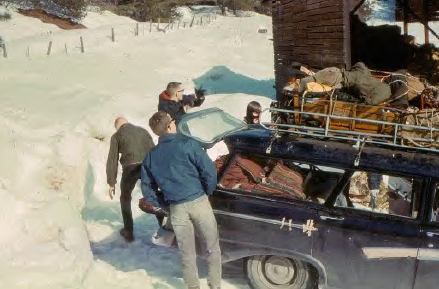
(Photo from a Boy Scout campout at Deer Park circa 1964.)
3
Obtained in the summer of 1968: 1949 pale green Plymouth.
I bought this vehicle while working in Seattle – grounds-keeping at a cemetery and some interior painting. Cost $50. It had a loud exhaust and I got a warning ticket in Seattle instructing me to get it repaired. On driving it back to Pullman at the end of the summer I was stopped on Hwy 195 between Spokane and Colfax by a Washington State patrolman for the loud exhaust. He asked for my registration and I fumbled through the glovebox for the pink registration, found a likely document and handed it to him. It was the Seattle warning ticket for a defective exhaust. He wasn’t impressed, but gave me another break, saying he patrolled this stretch of highway regularly and next time he’d nail me if I didn’t get it fixed. On pulling into Pullman I got a soup can and two hose clamps. Cutting the ends out of the soup cans and cutting the resulting cylinder lengthwise with tinsnips, I spliced together the exhaust pipe (it had rusted through completely) and solved the problem.
Later that year the Plymouth developed severe engine problems – it would not start without coasting and I used it only to get groceries at the Rosauer’s at the base of the Stadium Way hill. The engine was so weak I could only get back up the hill in reverse.
The winter of ’68-69 was extreme. Temperatures fell as low as -32 degrees F. (Jan. 1, 1969 – Pullman-Moscow Airport) and -48 degrees at Ice Harbor Dam near Walla Walla. The latter was the coldest temperature ever recorded in Washington State. Snowfall was very heavy over the Christmas vacation, which I spent at a friend’s in Seattle. I drove his VW Bug back to Pullman and my feet were numb and clumsy as ice blocks on arrival.
My Plymouth had been towed away when the city plowed the streets and by the time I could consider retrieving it from impoundment, the fee was over $100. The city inherited one Plymouth. And I hitchhiked for some time – including a visit to the Tolstoy Peace Farm near Ritzville the spring I was reading Nietzsche. Early in the summer I hitchhiked to San Francisco and spent the summer there looking for work. But these are other stories.
4
Obtained around 1969-1970: A black VW Bug. Maybe ’62 vintage?
Around this time I moved back to the Palouse and lived in Albion. This vehicle had belonged to brother Tom’s friend Dave Juckich. I don’t remember the cost. The driver’s seat was not bolted to the frame but could be moved back to rest against the back seat, giving me plenty of legroom. This also allowed easy access to the back seat and allowed me to requisition this Round Oak woodstove (see photo) from the fallen-down cabin where it was moldering in the Moscow Mountains.
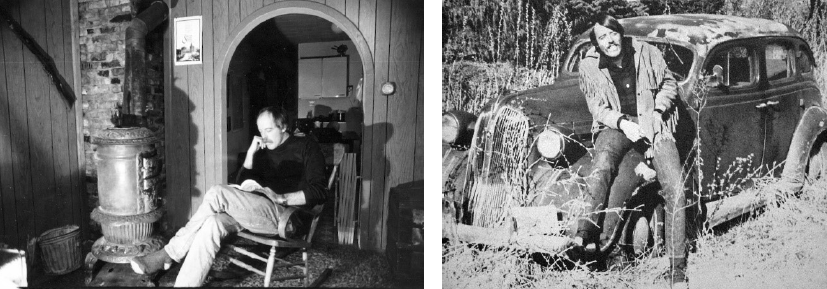
The photo at right dates from about 1970. This ’38 Plymouth (?) 4-door was parked semi-permanently outside our (freaky) farmstead in Albion. I never saw it move, but rumor was that it had been driven by Tad Suckling and others in bringing Peter, Paul, and Mary from the Pullman-Moscow Airport to their concert venue on the WSU campus. And that P, P, & M were unsettled by its rustic condition.
5
Obtained around 1970: 1950 Dodge panel truck.
This classic vehicle had a stovepipe that vented through the side of the truck for attachment to an interior stove. It had windows all around and had once belonged to some sort of (dude?) ranch or recreational site in Colorado. The truck had originally been green but had then been painted black, leaving only the ranch sign on the driver’s door still displayed in the original green. This vehicle transported old wooden furniture and a bit of contraband. After a bad winter, algae was found growing in the piston bores. I don’t believe it ever ran after that.
6
Obtained about 1972. ~1962 Saab. Blue.
A very odd car – 2-stroke, 3-cylinder, front-wheel drive with a “free-wheel” feature – meaning that it provided no compression braking when you let up on the accelerator. This was the year of my very short, unhappy, 9-month marriage to Jamie Crighton. When all fell apart, I resolved to drive across the country (Pullman WA to Schenectady NY) to meet her family. It was a long, strange, and memorable trip.
I piled most of my belongings and dog – Clancy, a gentle, understanding off-breed golden retriever – into the car and headed east. In the Midwest I picked up two hitchhikers (guys) and let one of them drive when I got sleepy. When I awoke, we’d been pulled over by a patrolman. Perhaps for speeding, I don’t recall. It was between midnight and dawn, but we were guided to a judge’s house to resolve the problem — perhaps because the driver had no money to pay the fine and we were clearly unlikely to hang around. My memory is incomplete on this, but at one point the cop and we stopped at a small store – to use the restroom(?). The hitchhikers and the cop went inside and I deduced that the cop(s) were giving me a break – so I drove the Saab off in a hurry, crossed over the freeway and headed east on back roads for the state line. They probably never followed me, but I was relieved when I crossed into the next state (Minnesota or Michigan).
Not being a quick learner, I picked up another hitchhiker who made a pass at me, so I let him out forthwith.
Next mistake? To save time (I thought) I took a route that passed through Canada. I-90 to Interstate 295 to Hwy. 69/410 and back into the US at Niagara Falls. The border guards pretty much tore the car’s insides apart searching for contraband – there was none. I put everything back together and carried on to Schenectady, avoiding the toll roads, which meant long roller-coaster grades over the rolling mountains.
After Schenectady (the stop at the Crighton’s was only modestly enlightening) I drove to Boston and slept in the Boston Commons. I awoke in my sleeping bag with Clancy barking at a squad car full of cops with their windows mostly rolled up. They advised me to get moving, and I did. Next, I stopped at Woods Hole and actually got a room at the old seaside inn. What remains vivid is seeing several skunks sharing the sidewalks as I ambled around town. From there I drove through NYC on the freeway and headed back west again.
Somewhere in New England I remember the gas mileage improving drastically. But also, the engine would kill every time I came to a stop. Opening the hood, I examined the carburetor. When I touched it, it fell off. The retaining bolts had shaken loose. Excess air was being drawn in at the base of the carburetor and the engine had been running extremely lean. Somehow (wire?, spare bolts?) I reattached the carburetor and continued.
I came back through Pennsylvania, Ohio, Indiana, Illinois, Iowa and Nebraska. In Nebraska, the car started stalling and when I checked, I found that the distributor was filling up with iron filings and the points were shorting out. I would clear out the iron filings and drive another twenty miles, then the engine would stall again. It got worse and worse. The shaft on the distributor was rapidly wearing away, throwing the iron filings into points. Finally, as the vehicle died, a snowstorm picked up and I was stranded at the side of the road. I slept in the car and in the morning flagged someone down who agreed to haul the car to the nearest town. From town I called around and found that the nearest Saab dealer and parts were in Bismarck ND – 2 states away.
I gave to car to the guy who had hauled me to town, then put most of my belongings on a Greyhound headed for Spokane. Because I couldn’t take Clancy on the bus, I hitchhiked with the bare essentials back to Spokane. Somewhere in Montana, while I was sleeping beside the freeway, my old Springfield 22 was stolen. Clancy didn’t even wake me. In Spokane I temporarily took up residence with my folks, who found a lawyer to help me settle the divorce.
7
Obtained about 1973. A 1948(?) Ford Pickup.
This lasted maybe a year while I lived in a cold-water flat by the Spokane River/Peaceful Valley. It had an icebox rather than a refrigerator and my nearest neighbor there was a one-legged Indian knife fighter with horrible headaches and a serious fortified wine habit.
Eventually I got a job as a laborer, then working for an environmental consultant, then as “field representative” for the Spokane County Air Pollution Control Authority.
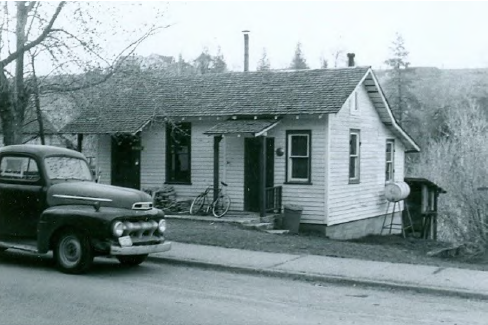
(Photo – Ford pickup in front of cold-water flat in Peaceful Valley, circa 1973.)
8
Obtained about 1973. A Blue Chevy II.
I don’t recall much about this vehicle.
9
Obtained about 1974. A Ford F-150 pickup. Early 60’s vintage. This truck had belonged to the USFS and had thus been painted the standard light green of the federal vehicles in that era. I had an angle-iron rack welded to the bed, with two washing machine rollers attached to the back crossbar. These were used when loading my canoe onto the rack. I also remember using this truck to haul firewood for me and recyclables for the Spokane Food Coop. On more than one occasion it was so heavily loaded (with bundled newspaper or lumber) that, on hitting a bump, the front wheels would actually rise off the road. This hindered steering somewhat.
On weekends I’d sometimes take the truck and canoe to 4th of July Lake in Lincoln County to flyfish for rainbow trout.
Eventually, when I left Spokane (late 1976) I sold the pickup to brother Tom.
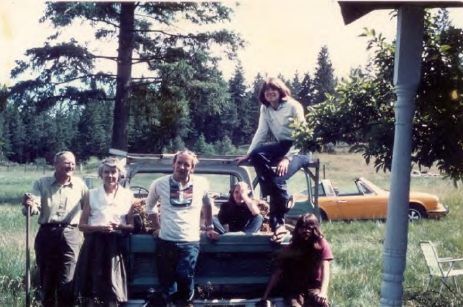
(Photo: F-150 at family farm with Dad, Mother, Tom, Betsy (in truck bed), Mary, and Eric Kowalski – Mary’s friend. Tom’s Porsche in background.)
10
About 1974, the Chevy II gave way to a 1963 Dodge Dart.
This was my most reliable car to date. Its slant-6 engine held up well as I drove it between Spokane and Pullman working on my Environmental Engineering master’s degree. The Dart lasted through a year’s residency in Pullman and a summer job as Stream Patrolman for the WS Department of Ecology, checking water withdrawal permits during the drought of 1977. The Dart moved me to Olympia in late 1977.
Eventually it too gave up the ghost. I remember parking it on a visit to my sister, Mary, in Seattle. The engine didn’t shut off, then I could see dancing shadows on the asphalt beneath the engine. On opening the hood, I found flames flickering from the carburetor.
11
Obtained in 1978. A small, used Ford Courier pickup (actually, a Mazda), maybe ’72 vintage(?) to replace the F-150 for wood and canoe hauling. It was a bit cramped, but serviceable. I spun it once in the snow driving from Tumwater to Tenino. No damage.
12
Early 1980’s. A blue Toyota Corolla hatchback.
A commuter vehicle between Tenino and work at the Ecology office near the Tumwater Airport.
13
Late 1980s. A Maroon Isuzu Trooper II.
My first new car. Cost about $10,000. This 4-cylinder vehicle picked up a theme from the early station wagons and the Dodge panel truck. It had relatively high clearance and room to sleep in back. It also had 4-wheel drive, a cassette deck, and a rack that allowed me to haul the canoe. This permitted relatively cheap road trips with access to back roads. Unfortunately, it wasn’t that sturdy and took something of a beating. In the end the driver’s door was sprung, so it wouldn’t completely close.
One memorable trip was a search for Lew Welch’s* hermit cabin in the Northern California Salmon River country. Welch, a poet and confederate of Jack Kerouac and Gary Snyder, lived in a remote cabin not far from the tiny town of Forks-of-Salmon. I met up with Greg Darms,** who was living, at the time, in Inverness CA, near Bolinas, on the coast north of San Francisco. We used hints from Welch’s collected letters I Remain to locate the remains of the cabin near a small pond up a ridge on the south side of the Salmon River. This car was also transportation to several poetry retreats: Centrum, Art of the Wild, etc.
It lasted until about 1995.
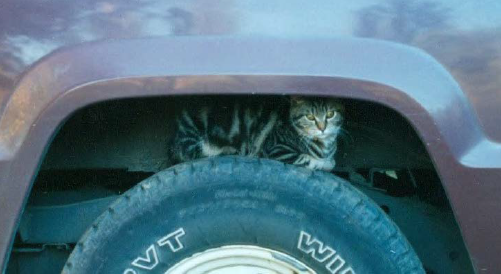
(Photo: My cat Catfish in the wheel well of the Trooper.)
14
Obtained in 1996. Green Toyota 4Runner with 4-cylinder engine.
As of 2019 this vehicle is running strong with over 180,000 miles in its 23 years of service. It’s provided transport for the canoe, kayaks, a row/sailboat and numerous road trips. Some of the most notable were fall camping trips with Matthew*** and Greg Darms to locations throughout Washington and Oregon, and occasionally into northeastern Nevada. A remarkably reliable vehicle with good gas mileage – 19-25 mpg.
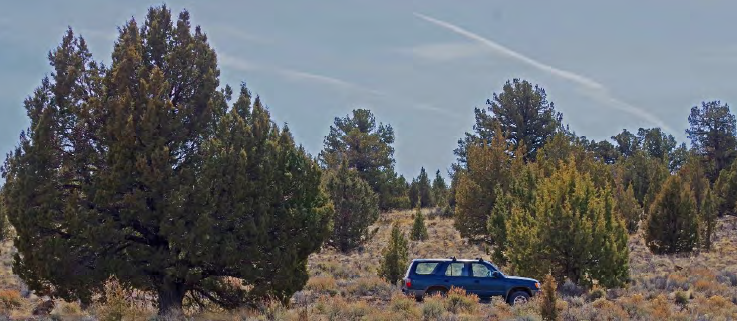
2019
* Lew Welch (1926-1971) — American Beatnik poet and essayist.
** Greg Darms — American poet, publisher, essayist. See AB №№ 17 (“Katagami“), 29 (“Certain Uncertainties: Speculative Readings of Emily Dickinson’s ‘This World is not conclusion’“).
*** The author’s son.

Speak Your Mind